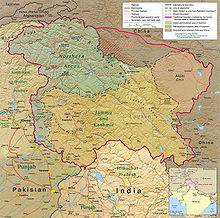Kashmiris
| Regions with significant populations | |||||||
|---|---|---|---|---|---|---|---|
| India, Pakistan | 5,362,349 (as at 2001)[1] | ||||||
| United Kingdom | 115,000-150,000[2] | ||||||
| Languages | |||||||
| Kashmiri Hindi,[3] Urdu,[3] or Punjabi[3] also spoken widely as second languages | |||||||
| Religion | |||||||
| Sunni Islam, Shi'a Islam,[4] Hinduism, Sikhism [5] | |||||||
| Related ethnic groups | |||||||
| Other Dardic peoples | |||||||

The Kashmiri people (Kashmiri: کٲشُر لُکھ / कॉशुर लुख) are a Dardic linguistic group living in or originating from the former British India state of Kashmir. That former state is disputed territory, comprising the Indian-administered state of Jammu and Kashmir, the Pakistani-administered territories of Azad Kashmir and Gilgit–Baltistan, and the People's Republic of China-administered regions of Aksai Chin and Trans-Karakoram Tract.
Language
According to language research conducted by the International Institute of UCLA, the Kashmiri language is "a Northwestern Dardic language of the Indo-Aryan branch of the Indo-Iranian subfamily of the Indo-European language family." There is, however, no universally agreed genetic basis for the language. UCLA estimates the number of speakers as being around 4.4 million, with a preponderance in the Kashmir Valley,[6] whereas the 2001 census of India recorded 5,362,349 throughout India, and thus excluding speakers in the non-Indian Kashmiri areas.[1] The Kashmiris living in Azad Kashmir speak Pothohari dialect that is also known as Pahari language. Pothohari is also spoken in neighboring regions as well.[7]
Introduction of Islam
By the 19th century, Islam had supplanted Hinduism as the dominant religion in Kashmir, starting with the conversion in 1323 of Rincana, the first king of a new dynasty from Ladakh, at the hands of the saint, Bulbul Shah.[8] After conversion to Islam He called himself Malik Sadur-ud-Din and was the first Muslim ruler of Kashmir. He was subsequently killed by the Kashmiris. Since the arrival of foreign invaders in 7th century AD and the start of religion conflicts, before the partition of South Asia, majority of the Hindus and Buddhists of Kashmir migrated and settled in different regions.[9][10][11]Migrants from different states of India and Pakistan, as well as, few from Afghanistan and Iran have also since settled in Kashmir.[12] Many of these people retain their identity. The Muslims and Hindus of Kashmir lived in relative harmony as under the Sufi (Islam) and Reshi (Hindu) tradition of Kashmir. Today most of the current Kashmiris are Muslim and a sizable number of Kashmiri Hindu community exists.[13][14]
Migration
Drought of 1800
During 1800, a severe drought swept across Kashmir, which caused many in the region to migrate out of the Kashmir Valley, and south of the Jhelum River into what the Punjab region.[15] Those who migrated entered mainly into agriculture, and by the 1820s, after the drought passed, many of the Kashmiri immigrants returned to the Kashmir Valley. Some, however, remained in Punjab as they had settled comfortably. Some chose to continue migrating southwards.[16][17][18]
Culture
The social structure is based on the extended family. However the wider kinship network of biraderi and how it impacts on relations and mobilization is equally important. The extended family is of fundamental importance as a unit of decision making and with respect to the relations of its members with wider society. The institution of biraderi*mdash;which loosely means brotherhood—provides a useful collective framework for promoting mutual well-being. This is achieved through help and co-operation in social, economic and political spheres and it reinforces a sense of belonging and collective self-assurance.[19]
See also
References
- ^ a b "Abstract of speakers' strength of languages and mother tongues – 2001". New Delhi: Office of The Registrar General & Census Commissioner. 2001. Retrieved 25 March 2012.
- ^ http://www.communities.gov.uk/documents/communities/pdf/1170952.pdf
- ^ a b c "Kashmiri: A language of India". Ethnologue. Retrieved 14 May 2008.
- ^ The Problems Of The Northern Areas
- ^ "Safety fears for Kashmir's Sikhs". BBC News. 21 March 2000. Retrieved 7 May 2010.
- ^ "UCLA Languages Project: Kashmiri". UCLA International Institute. Retrieved 24 March 2012.
- ^ Corbridge & Hariss & Jeffrey. (2012). India today: Economy, politics and society (politics today. Polity
- ^ Troll, C. (1982). Islam in india: Studies and commentaries. Stosius Inc/Advent Books Division.
- ^ Gottschalk, P. (2012). Religion, science, and empire: Classifying hinduism and islam in british india . (pp. 400, 234-354). USA: Oxford University Press.
- ^ Hees, P. (2002). Indian religions: A historical reader of spiritual expression and experience . NYU Press
- ^ Bayly, S. (2001). Caste, society and politics in india from the eighteenth century to the modern age (the new cambridge history of india). (1st & 4th ed.). Cambridge University Press.
- ^ Sevea, I. (2012). The political philosophy of muhammad iqbal: Islam and nationalism in late colonial india. (pp. 49-74). Cambridge University Press.
- ^ James & Pandey & Bansod & Subaiya. (2010). Population, gender and health in india: Methods, processes and policies. Academic Foundation
- ^ Jones, J. (2011). Shi'a islam in colonial india: Religion, community and sectarianism. Cambridge Studies in Indian History and Society.
- ^ Kashmiris’ contribution to Ludhianvi culture. The Tribune. Retrieved 25 March 2007.
In fact, the Ludhiana hosiery industry owes its origin to Kashmiris. According to the Ludhiana District Gazetteer, during a devastating famine in the 19th century a number of Kashmiris migrated to Ludhiana. They are known world over for their handicraft skills. They started weaving woollen fabric here. Slowly the trade got popular and Ludhiana started to be identified with hosiery only.
- ^ http://www.sam.gov.tr/perceptions/Volume9/June-August2004/hilali.pdf
- ^ Sarila, N. (2009). The shadow of the great game : The untold story of indias partition. HarperCollins.
- ^ Phillips & Wainright (1970). The partition of india. The MIT Press.
- ^ Diasporic Communities and Identity Formation:
Further reading
- Kashmir freedom movement and indian occpuition By Yodhishter Kahul, Yudhistar ed Kahol
- The Crisis in and struggle for freedom in Kashmir: Portents of War, Hopes of Peace By Šumit Ganguly




